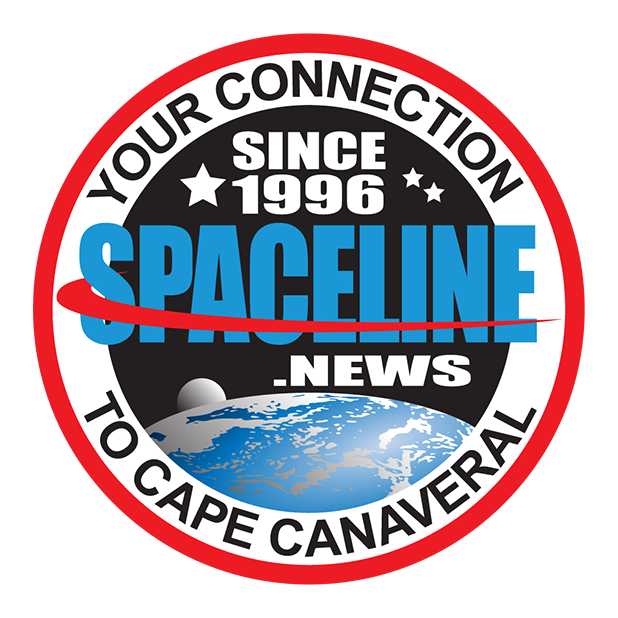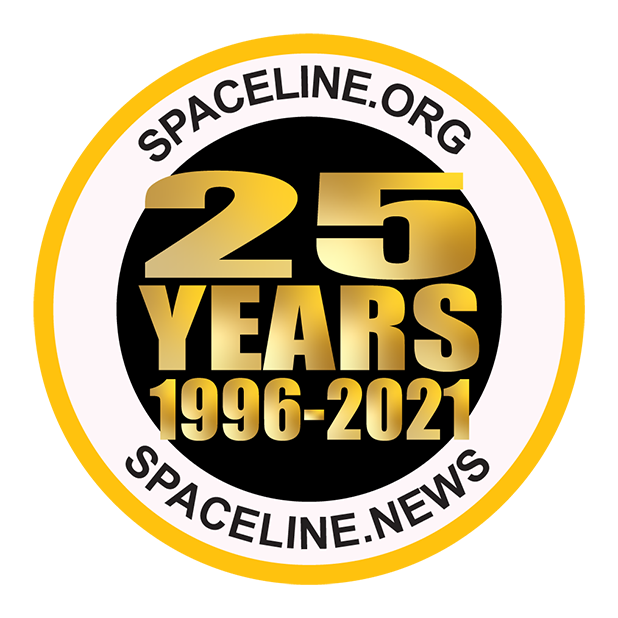Spaceline News Archives
November 2020

Falcon 9 Starlink V1.0-L15 Launch, Photo Courtesy SpaceX
Falcon 9 Launches Next Batch Of Starlink Satellites
November 24, 2020 | Reported by Cliff Lethbridge
A SpaceX Falcon 9 rocket successfully launched 60 Starlink broadband Internet satellites at 9:13 p.m. EST today from Launch Pad 40 on Cape Canaveral Air Force Station. Launch was originally set for November 22, 2020 but was postponed to allow engineers to review data and due to bad weather in the booster recovery area offshore. The Starlink satellites, on a mission called Starlink V1.0-L15, were successfully deployed about 15 minutes after launch. The first stage booster employed today, dubbed the "fleet leader" by SpaceX, was being flown for a record seventh time. It had flown previously on the Telstar-18 VANTAGE mission in September, 2018, the Iridium-8 mission in January, 2019 and four Starlink missions in May, 2019, January, 2020, June, 2020 and August, 2020. Falcon 9 first stage boosters currently in use are designed to be launched up to ten times without refurbishment, and up to 100 times with periodic refurbishment.

Falcon 9 Starlink V1.0-L15 Streak Shot, Photo Courtesy SpaceX
Today, the "fleet leader" was successfully recovered with a landing on the "Of Course I Still Love You" drone ship positioned on the Atlantic Ocean about 400 miles northeast of Cape Canaveral. The rocket's fairing halves, one having flown once previously and one having flown twice previously, were also recovered on the Atlantic Ocean by specialized recovery vessels. This was the sixteenth batch of Starlink satellites launched to date, marking a total of 955 launched since May, 2019. Starlink is a constellation of satellites intended to provide space-based Internet service to unserved or underserved areas, or as an alternative to traditional Internet service. On a test basis, Starlink Internet service is already available in the northern United States and southern Canada. SpaceX hopes to have the system available to the entire world some time in 2021.

Falcon 9 Starlink V1.0-L15 Engine Fan, Photo Courtesy Carleton Bailie/Spaceline

Falcon 9 On Launch Pad 40, Photo Courtesy Carleton Bailie/Spaceline
Falcon 9 Starlink Launch Scrubbed
November 22, 2020 | Reported by Cliff Lethbridge
Launch of a SpaceX Falcon 9 rocket scheduled for 9:56 p.m. EST today has been scrubbed. SpaceX said the scrub was called to allow engineers to "complete data review" but no specific problem was cited. The company has tentatively reset the launch for Monday, November 23, 2020 at 9:34 p.m. EST but they are keeping an eye on recovery weather. Launch will be from Pad 40 on Cape Canaveral Air Force Station and the rocket will be carrying 60 SpaceX-owned Starlink broadband Internet satellites.

Falcon 9 On Launch Pad 40, Photo Courtesy Carleton Bailie/Spaceline

Crew-1 Astronauts Depart For Launch, Photo Courtesy NASA
Falcon 9 Launches Four Astronauts To International Space Station
November 15, 2020 | Reported by Cliff Lethbridge
A SpaceX Falcon 9 rocket successfully launched the Crew-1 mission to the International Space Station (ISS) at 7:27 p.m. EST today from Launch Pad 39A at the Kennedy Space Center. Launch was originally set for Saturday, November 14, 2020 but was postponed due to bad weather in the abort and recovery areas offshore. The first stage booster employed today was being flown for the first time and was successfully recovered with a landing on the "Just Read the Instructions" drone ship positioned on the Atlantic Ocean about 400 miles northeast of Cape Canaveral. A Crew Dragon spacecraft named "Resilience" by the crew carried NASA astronauts Michael Hopkins, Victor Glover, Shannon Walker and Japanese Aerospace Exploration Agency (JAXA) astronaut Soichi Noguchi on a journey to ISS. Crew Dragon is scheduled to autonomously dock to the forward port of the space station's Harmony module at about 11:00 p.m. EST on Monday, November 16, 2020.

Falcon 9 Crew-1 Launch, Photo Courtesy SpaceX
The Crew-1 mission is the first of at least six Crew Dragon crewed missions under the NASA Commercial Crew Program. The mission has several firsts, including the first manned flight of a NASA-certified commercial launch system, the first international crew of four to launch on an American commercial spacecraft, the first time an ISS crew will grow from six to seven members and the first time that the Federal Aviation Administration has licensed a human orbital space flight. Astronaut Noguchi also became the first astronaut to fly in space in three separate vehicles (Space Shuttle, Soyuz and Crew Dragon) since John Young (Gemini-Titan II, Saturn V Apollo and Space Shuttle) and Wally Schirra (Mercury-Atlas, Gemini-Titan II and Saturn IB) also performed the same feat.

Falcon 9 Crew-1 Launch, Photo Courtesy SpaceX
Hopkins, Glover, Walker and Noguchi will be joining the ISS Expedition 64 crew on a six-month mission. The Expedition 64 crew currently consists of Russian Space Agency cosmonauts Sergey Ryzhikov and Sergey Kud-Sverchkov and NASA astronaut Kate Rubins. The crew will conduct a host of science and maintenance activities in the longest scheduled ISS mission launched from U.S. soil. The Crew Dragon spacecraft is able to stay in space for a maximum of 210 days. In addition to the astronauts, Crew Dragon carried more than 500 pounds of cargo, including science hardware and experiments. At the conclusion of this mission, the Crew-1 astronauts will board "Resilience", which will then autonomously undock with ISS and re-enter Earth's atmosphere. Crew Dragon can splash down at sea at one of seven sites in the Atlantic Ocean and Gulf of Mexico. The spacecraft is then recovered on a SpaceX vessel and returned to shore.

Falcon 9 Crew-1 Launch, Photo Courtesy SpaceX

Atlas V NROL-101 Launch, Photo Courtesy Liz Allen/Spaceline
Atlas V Scores Success With NROL-101 Launch;
Falcon 9 Crew-1 Launch Postponed
November 13, 2020 | Reported by Cliff Lethbridge
A United Launch Alliance (ULA) Atlas V rocket successfully launched the NROL-101 payload at 5:32 p.m. EST today from Launch Pad 41 on Cape Canaveral Air Force Station. Launch was originally scheduled for November 4, 2020 but was delayed due to a problem with ground system liquid oxygen valves. Today's launch was delayed 19 minutes due to a couple of technical glitches in the countdown. The Atlas V launched today was in the 531 configuration, featuring a 5-meter payload fairing, three solid rocket boosters and a single-engine Centaur upper stage. For the first time, an Atlas V was launched with Northrup Grumman GEM-63 (Graphite Epoxy Motor-63) solid rocket boosters, replacing Aerojet Rocketdyne AJ-60A solid rocket boosters flown on previous Atlas V rockets. Each GEM-63 solid rocket booster is 5 feet. 3 inches in diameter and 66 feet long and can produce a thrust of 371,550 pounds. Incorporation of these new solid rocket boosters increases total Atlas V vehicle thrust at launch to 1.8 million pounds.

Atlas V NROL-101 Ascent, Photo Courtesy Liz Allen/Spaceline
The rocket carried NROL-101, a classified payload for the National Reconnaissance Office. ULA confirmed mission success several hours after the launch. In related news, launch of a Falcon 9 Crew Dragon on the Crew-1 mission has been postponed to Sunday, November 15 at 7:27 p.m. EST. Launch was previously set for Saturday, November 14, 2020 at 7:49 p.m. EST but was postponed due to unacceptable weather on the Atlantic Ocean downrange of Cape Canaveral. Downrange weather must be acceptable in case an unforeseen launch failure occurs, forcing an emergency splashdown downrange of the launch site. The Crew-1 launch will be from Launch Pad 39A at the Kennedy Space Center and will be the first operational crew launch to the International Space Station under the NASA Commercial Crew Program. Four astronauts will be aboard Crew Dragon for this launch.

Falcon 9 Crew-1 On Launch Pad 39A, Photo Courtesy SpaceX

Falcon 9 GPS III-SV04 Launch, Photo Courtesy Carleton Bailie/Spaceline
Falcon 9 Successfully Launches GPS III-SV04 Satellite
November 5, 2020 | Reported by Cliff Lethbridge
A SpaceX Falcon 9 rocket successfully launched the GPS III-SV04 satellite at 6:24 p.m. EST today from Launch Pad 40 on Cape Canaveral Air Force Station. Launch was originally set for October 2, 2020 but the rocket suffered a launch pad abort just two seconds before launch due to a ground support issue. The first stage booster employed today was being flown for the first time and was successfully recovered with a landing on the "Of Course I Still Love You" drone ship positioned on the Atlantic Ocean about 400 miles northeast of Cape Canaveral. The satellite payload was successfully deployed about 90 minutes after launch. GPS III-SV04 (Global Positioning System III-Space Vehicle 04) is the fourth in a planned constellation of ten next generation GPS satellites. The GPS III series of satellites is intended to deliver sustained, reliable GPS capabilities to America's warfighters, U.S. allies and civilian users. GPS provides positioning, navigation and timing service to civilian and military users worldwide, with the goal of fulfilling increasing demands for the GPS system. System improvements introduced with the GPS III series include improved anti-jamming, improved accuracy and improved integrity. The satellites operate on six orbital planes at 55-degrees inclination at an altitude of about 12,000 miles. Design life is 15 years with 12 years mean mission duration. Launch weight of the satellite was about 8,000 pounds. Position accuracy is within 0.63 meters. Prime contractor for GPS III-SV04 is Lockheed Martin.

Falcon 9 GPS III-SV04 Launch, Photo Courtesy Carleton Bailie/Spaceline

Atlas V NROL-101 On Launch Pad 41, Photo Courtesy Liz Allen/Spaceline
Atlas V NROL-101 Launch Scrubbed
November 4, 2020 | Reported by Cliff Lethbridge
Launch of a United Launch Alliance (ULA) Atlas V rocket scheduled for 5:54 p.m. EST today has been scrubbed. The launch countdown was halted at Launch Minus 1 hour, 47 minutes due to a technical difficulty and was never resumed. The rocket was never filled with fuel. In a press release, ULA said that the problem was "an unexpected system response from remotely commanded ground system liquid oxygen valves." There was not enough time left in the launch window for the problem to be successfully resolved. Launch has been rescheduled for Sunday, November 8 at 5:36 p.m. EST. Launch will be from Launch Pad 41 on Cape Canaveral Air Force Station and the rocket will be carrying NROL-101, a classified payload for the National Reconnaissance Office.

Atlas V NROL-101 On Launch Pad 41, Photo Courtesy Liz Allen/Spaceline

















